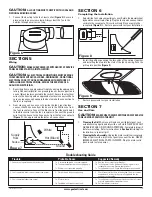
210572119 Rev. D 1-08
GENERAL SAFETY INFORMATION
(Continued)
CAUTION:
FOR GENERAL VENTILATING USE ONLY. DO NOT
USE TO EXHAUST HAZARDOUS OR EXPLOSIVE MATERIALS AND
VAPORS.
6.
When cutting or drilling into wall or ceiling, do not damage electrical
wiring and other hidden utilities.
7.
Ducted fans must always be vented to the outdoors.
8.
This unit must be grounded.
9.
To avoid motor bearing damage and noisy and/or unbalanced
impellers, keep drywall spray, construction dust, etc. off power unit.
WARNING:
TO REDUCE THE RISK OF FIRE, ELECTRIC SHOCK,
DO NOT USE THIS FAN WITH ANY SOLID-STATE SPEED CONTROL DEVICE.
10. Acceptable for use over a bathtub or shower when installed in a
GFCI protected branch circuit.
11. NEVER place a switch where it can be reached from a tub or shower.
WARNING:
DO NOT USE IN KITCHENS
INSTALLATION INSTRUCTIONS
CAUTION:
MAKE SURE POWER IS SWITCHED OFF AT SERVICE
PANEL BEFORE STARTING INSTALLATION.
SECTION 1
Preparing the Exhaust Fan
1.
Unpack fan from the carton and confirm that all pieces are present.
In addition to the exhaust fan you should have:
1 - Grill
1 - Damper Assembly (attached)
1 - Mounting Bracket
1 - Hardware Bag
1 - Electrical Connector
3 - Wire Nuts
1 - Instruction/Safety Sheet
2.
Remove the wire compartment cover and store in the carton until
needed so it does not get damaged or lost
(Figure 1)
.
3.
Choose the location for your fan. To
ensure the best air and sound
performance, it is recommended that
the length of ducting and the number
of elbows be kept to a minimum, and
that insulated hard ducting be used.
Larger duct sizes will reduce noise and
airflow restrictions.
4.
Select the most convenient electrical
knockout and remove using a straight-
blade screw driver
(Figure 2)
.
SECTION 2
New Construction
1.
Using the gauge on the mounting bracket, line up the bracket on
the joist so the bottom of the fan will be flush with the finished
ceiling. Nail or screw the bracket in place securely
(Figure 3)
.
2.
Snap the fan body into the bracket
(Figure 4)
. The fan can be
snapped into position with the duct collar facing to the left or the
right depending which is most convenient.
SECTION 3
Existing Construction
1.
Position housing against the joist or stud and trace an outline of
the housing onto the ceiling/wall material. Set housing aside and
cut opening, being careful not to cut or damage any electrical or
other hidden utilities
(Figure 5)
.
2.
Line up the bracket on the joist so the bottom of the fan will be
flush with the finished ceiling. Nail or screw the snap-in bracket
in place securely
(Figure 3)
.
3.
Snap the fan body into the bracket
(Figure 4)
. The fan can be
snapped into position with the duct collar facing to the left or the
right depending which is most convenient.
SECTION 4
Ducting
Figure 1
Figure 2
1
/
2
"
3
/
4
"
Figure 3
Figure 4
Figure 5
2 of 4
www.geelectrical.com






















